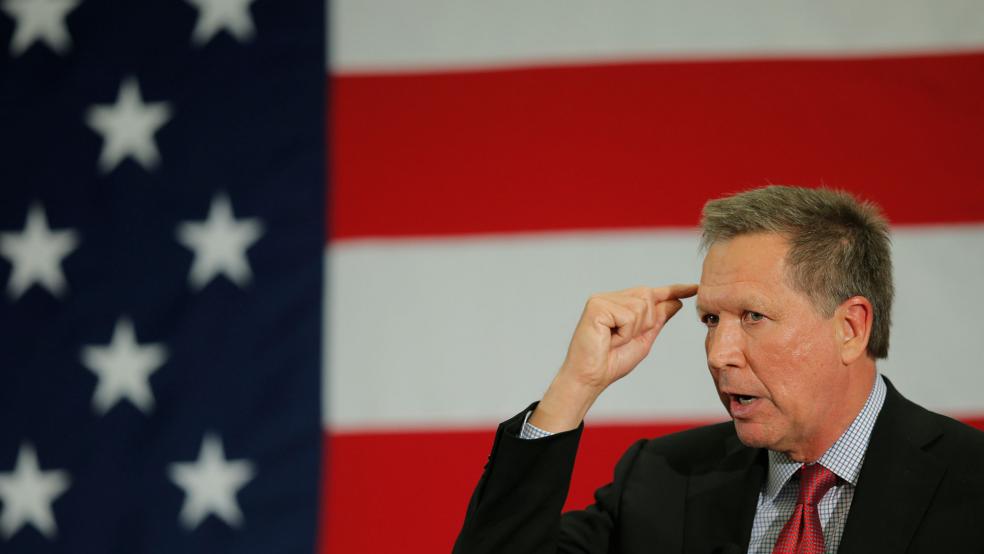Ohio Governor John Kasich is hoping his delayed decision to throw his hat in the ever-widening circle of GOP nominees for president could give him enough of a boost in the polls to qualify for the first Republican debate on August 6. He is currently polling at 3 percent and in 12th place, but the news of his candidacy could bump him up—especially if Donald Trump’s commanding lead erodes.
With his campaign now in full swing, Kasich plans to visit New Hampshire, South Carolina, Iowa, and Michigan this week and tape interviews with Fox News, ABC’s This Week, and NBC’s Meet the Press.
Here are some little-known facts about the newest republican candidate who refers to Bono as one of his good friends.
- Kasich is known for his short fuse and unpredictable tantrums. During a Koch brothers sponsored-conference, he raised his voice to Randy Kendrick, wife of Arizona Diamondbacks owner Ken Kendrick who questioned him about his push for Medicaid expansion. His rude response caused 20 people in the audience to walk out. Two other governors on stage, Nikki Haley of SC and Bobby Jindal of LA told him they disagreed with what he had said. Even famously fiery John McCain has acknowledged Kasich’s temper.
- He invoked religion into his decision to accept the Medicaid expansion money offered under Obamacare in 2013. He told a reporter, “Now, when you die and get to the meeting with St. Peter, he’s probably not going to ask you much about what you did about keeping government small. But he is going to ask you what you did for the poor. You better have a good answer.”
- During a June 1991 Grateful Dead concert, Kasich tried to climb onto the stage, but he was stopped by tour organizers. Observers recall he was trying to use his status as a Congressman to get on stage. Kasich counters those stories saying he thought the pass he was wearing around his neck would allow him on stage so he argued with the person who was trying to kick him off. It turns out Kasich was invited on stage for the opening act of the show, not the Dead’s set.
- As an 18-year-old freshman at Ohio State in December 1970, Kasich wrote a letter to President M. Nixon asking to meet with him. Two weeks later, Nixon extended an invitation for Kasich to come to the White House for a 20-minute conversation.
- He’s a former host of a Fox News show. “From the Heartland with John Kasich” was on-air for six years, premiering in 2001 after he left Congress. The show aired on Saturday evenings and was broadcast from Columbus, Ohio.
- In addition to working for Fox, Kasich also began working in 2001 as a managing director at Lehman Brothers until the Wall Street firm collapsed in 2008. He returned to politics in 2010 by beating the incumbent Ohio Governor Ted Strickland by a two-point victory.
- Already a religious man, his faith has grown since the late 1980s when his parents, two Democratic postal workers, were killed in a car crash with a drunk driver while pulling out of a Burger King. A devoted Catholic before having his faith wane in college, Kasich now attends an Anglican church.
- He’s currently polling at a strong 60 percent approval rating in Ohio, a pivotal swing state. Republicans will almost certainly need to win Ohio in order to win the White House. The last president who won without Ohio was John F. Kennedy in 1960. His approval rating is different from some of his rivals who are seen more negatively than positively in their home states, such as Wisconsin Governor Scott Walker.
- Kasich refuses to use teleprompters, even for his State of the State addresses that can last over an hour. Either he uses a written speech, a rough outline with talking points, or he improvises the entire speech.
- After pushing a bill to restrict collective bargaining rights for public workers in 2011, Kasich backed off when voters passed a referendum, 62 percent to 38 percent, to repeal the bill. The legislation would have limited the rights of 350,000 public workers, including police, teachers, and firefighters. His approval rating fell into the low 30-percent range, but he accepted the defeat and looked for other budget cuts.





